My Cluster Tab
My cluster opens as the first tab of the Dashboard screen when you select Dashboard from the navigation menu. It displays numeric and tabular information for the "current" cluster (selected in the cluster selector tool on the main toolbar).
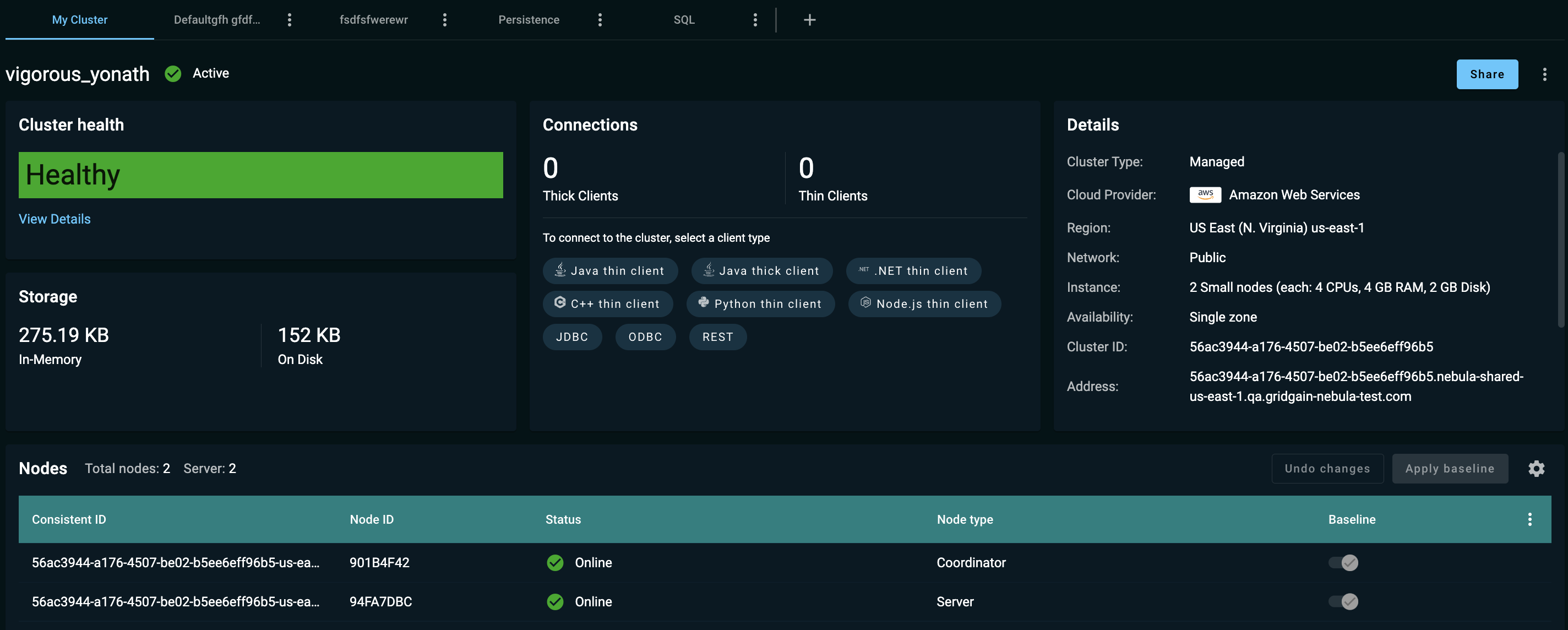
Viewing Cluster Information
Use the widgets to view the relevant cluster information:
| Widget | Description |
|---|---|
Cluster Health |
The cluster status:
|
Storage |
The amount of memory the cluster uses:
|
Connections |
The cluster connection counters for thin and thick clients. A set of chips for adding connections. |
Details |
A table of the cluster details, including |
Nodes |
A list of cluster’s nodes. |
Viewing Cluster Health Details
To view details of the cluster health (status), in the Cluster Health widget, click the View Details link. The Cluster Health Details dialog shows what specific problems, if any, are observed in the cluster.
For GridGain 8 and Apache Ignite clusters:
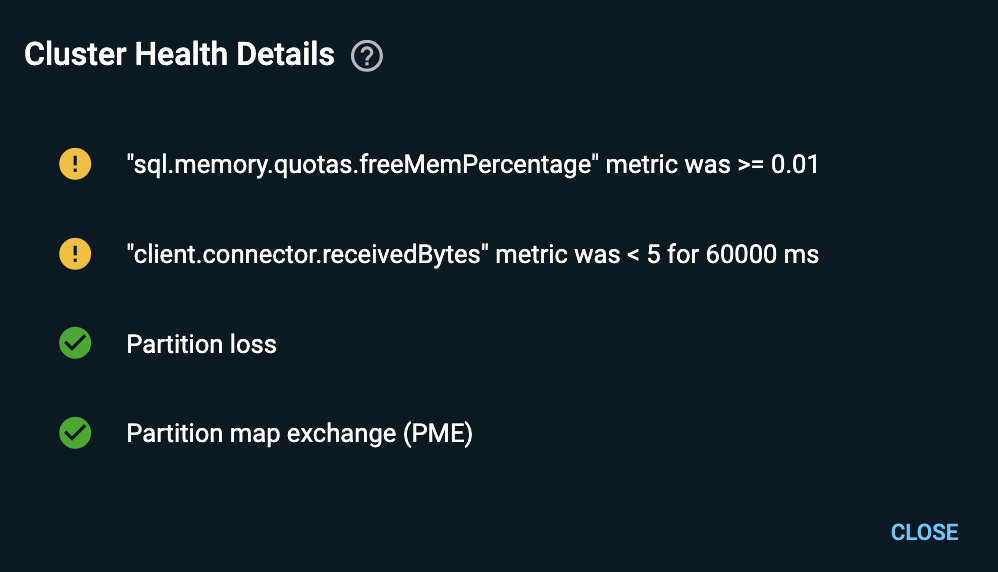
For GridGain 9 clusters:

Viewing Cluster Nodes
BThe cluster nodes are shown in the Nodes widget at the bottom of the screen.
To auto-size a specific column or all columns in the table, select the corresponding option from the column’s context menu.
To add columns to the table or remove them from the table, select the Table Columns option from the table’s context menu, then select or clear check boxes for the columns on the list that opens.
To define the auto-adjustment timeout, click the Configuration icon above the node list, toggle the auto-adjustment on, then enter the timeout value (in seconds).
GridGain 8 and Apache Ignite
By default, the Nodes widget displays the following columns for GridGain 8 and Apache Ignite clusters:
| Column | Description |
|---|---|
Consistent ID |
The consistent ID of the node. |
Node ID |
The ID of the node. |
Status |
Whether the node is online. A node that goes down remains registered in the baseline topology until you manually remove it or until it’s removed automatically through baseline autoadjustment. |
Node Type |
The type of the node: "Coordinator" or "Server." |
Baseline |
A toggle that enables removing the node from the baseline or adding it to the baseline. |
By default, the widget displays only server nodes. To add client nodes to the widget, in the Nodes context menu, toggle on Show client nodes.
GridGain 9
For GridGain 9 clusters, the Nodes widget displays the following columns:
| Column | Description |
|---|---|
Name |
The node name. |
Node ID |
The ID of the node. |
Host |
The cluster host IP address. |
Port |
The cluster host port. |
CMG |
Whether the node is included in Cluster Management Group. |
MS |
Whether the node is included in the Metastorage Group. |
HTTP, HTTPS ports |
The ports the node exposes. |
Status |
|
Viewing Graphic Dashboards
To view the default graphic dashboard for the current cluster, click the Default next to the My cluster tab in the top left corner of the screen.
Switching Between Clusters
If multiple clusters are registered in GridGain Nebula, you can switch between clusters by using the Select cluster control on the top toolbar.
Adding Connections
To add a connection to the cluster, in the Connections widget:
-
Click the required client/protocol chip.
-
Proceed to define the new connection.
Managing Cluster API Credentials
To access a cluster, applications need to authenticate to it using API "user" credentials. When creating a cluster, you specify one set of API credentials. Once the cluster had been provisioned, you can add API credential sets, modify them, and delete the ones that are no longer required.
To manage API credentials:
-
From the context menu, select API credentials.
The Manage API credentials dialog opens. It list all API "users" defined for the cluster.

-
To add a "user":
-
Click Add API credentials.
The Add API credentials dialog opens.

-
Enter the Username and Password values.
-
Click Add.
-
-
To change a "user" password:
-
From the user’s context menu, select Change password.
The Change password for <username> dialog opens.
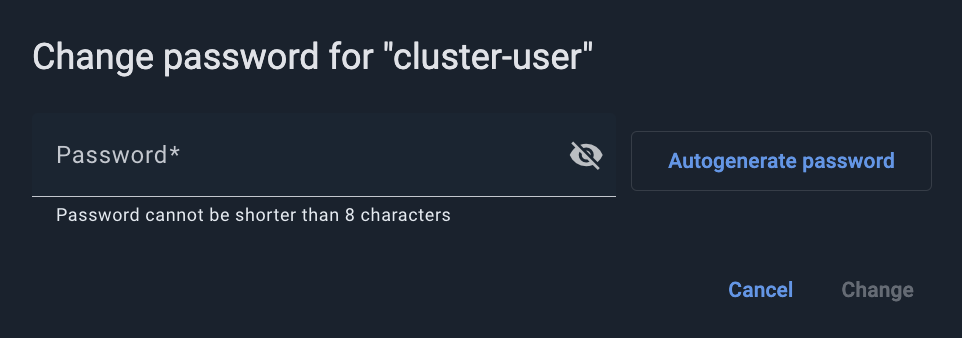
-
Enter the new Password.
-
Click Change.
-
-
To remove a "user", select Remove from that user’s context menu.
Sharing Clusters
You can have access to a cluster as:
-
User - a regular user who can view the cluster that had been shared with them individually or via a team, as well as utilize the actions that appear in the cluster’s context menu.
-
Owner - the user who had created or attached the cluster. Owners have extended cluster access rights, including sharing the cluster with teams or users, suspension, removal, etc.
As a cluster owner, you can share that cluster with individual users and/or teams.
Sharing with Users and Teams
To share the current cluster, click Share above the Details widget. The Share cluster dialog opens.
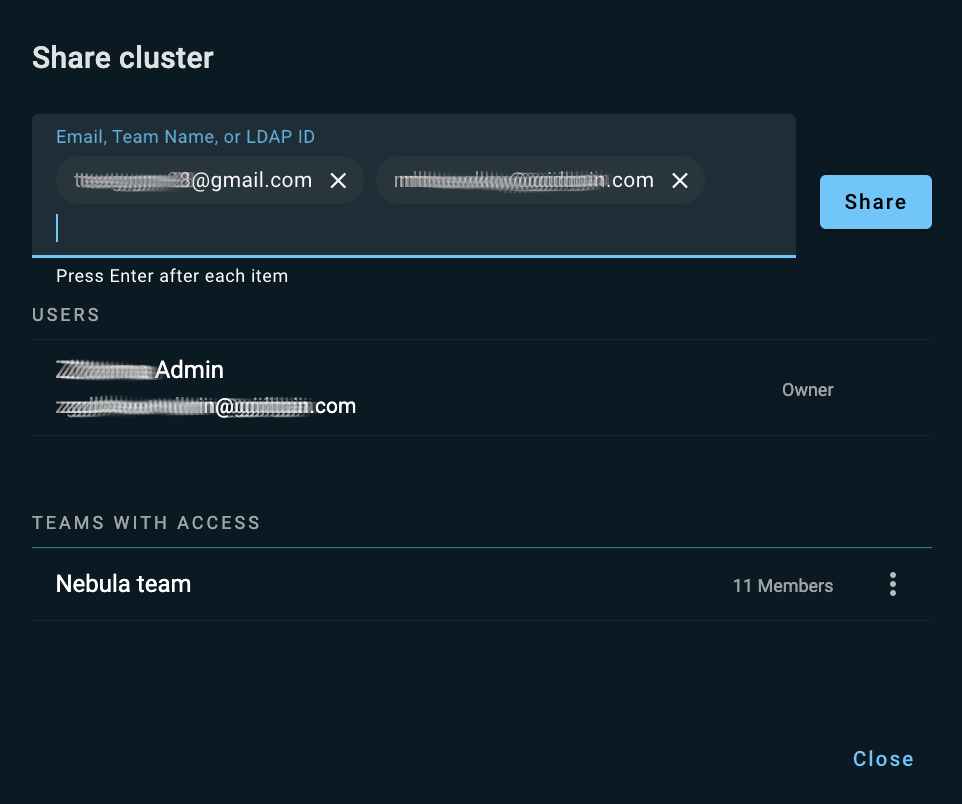
The dialog lists users and teams that already have access to the cluster.
In the entry field across the top of the Share cluster dialog, start typing a GridGain Nebula user’s email, an LDAP ID, or a team name. As you type, the incremental search mechanism displays suggestions in a drop-down list. Select one of the suggested users or teams. Alternatively, type the identifier to the end, then click [Enter]. You can add multiple users and/or teams in a single operation. When done, click Share.
The users and teams you have entered appear in the corresponding sections of the Share cluster dialog. The system notifies the users and team members that a cluster had been shared with them. To close the Share cluster dialog, click Close.
Stopping a Cluster Share
As a cluster owner, you can stop sharing your cluster with a team or with an individual user (remove access to the cluster that had been previously granted to that team or user).
To stop sharing a cluster with team(s) and/or user(s), click Share above the Details widget.
IN the Share cluster dialog that opens, select Stop sharing from the context menu by the required team or user name. In the confirmation dialog, click Stop sharing.
Activating and Deactivating Cluster
If your current cluster is active, you can deactivate it by selecting the Deactivate option from the context menu next to the Share button, then clicking Deactivate in the confirmation dialog.
If your current cluster is inactive, you can activate it by clicking the Activate button at the top of the screen, then clicking Activate in the confirmation dialog.
Initializing the Cluster
To initialize the attached GridGain 9 cluster:
-
Click Initialize in the top right corner.
The Initialize cluster dialog opens.
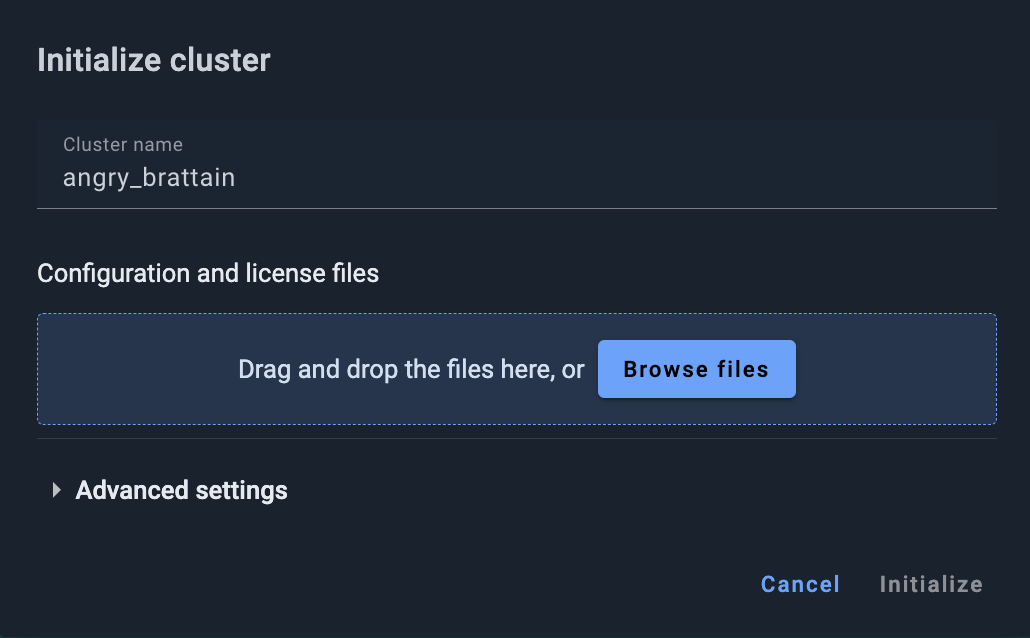
-
Add configuration and license file(s) using the Browse button or by dragging and dropping.
-
Optionally:
-
Expand the Advanced settings section.

-
Clear the Cluster Management Group (CMG) nodes same as MS nodes check box.

-
Manually assign MS and CMG nodes.
-
To reset the MS and CMG nodes to default configurations, click Reset to default.
-
-
Click Initialize.
The dialog closes. Once the initialization process is completed, the cluster status in the My Cluster screen changes to Active.
Changing Encryption Definitions
If the cluster has been created with the transparent encryption enabled, you can change its encryption definitions (the CMK and, optionally, the Access policy) after you rotate the CMK in your AWS account or create a new CMK.
To change the encryption definitions:
-
Select Data encryption from the context menu next to the Share button.
-
In the Data encryption dialog that opens, click Change CMK key.

-
In the Edit data encryption dialog that opens, replace the current Customer managed Key ARN with the new KMS ARN value, then click Continue.

-
Optionally, follow instructions in Step 2 to update the access policy, then click Save.

Adding Clusters
To add a cluster, click + on the top toolbar. From the menu that opens, select an option:
-
Create managed cluster - proceed to cluster creation instructions
-
Attach cluster - proceed to cluster attachment instructions
Next Steps
© 2025 GridGain Systems, Inc. All Rights Reserved. Privacy Policy | Legal Notices. GridGain® is a registered trademark of GridGain Systems, Inc.
Apache, Apache Ignite, the Apache feather and the Apache Ignite logo are either registered trademarks or trademarks of The Apache Software Foundation.
